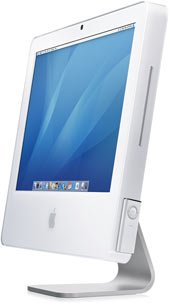Apple iMac, Intel core-dual based

Do people really have burning questions about something as familiar as Apple’s iMac? They do when that iMac ships with an Intel-built processor inside.
Apple kicked off the Intel transition at this year’s Macworld Expo by unveiling two new iMac models, powered by 1.83GHz and 2.0GHz Intel Core Duo chips, respectively. Both the 17-inch and 20-inch iMacs are shipping now.
What can you expect from the first batch of Intel-powered iMacs? We’ve done some digging to find out the answers to your questions.
If all the software out there won’t run natively on the new iMac, why should I buy one instead of the old model?
That all depends on how adventurous you are. The new Intel iMacs cost the same as the PowerPC iMacs, but offer two processor cores instead of one, faster RAM, and improved video features. At the same time, however, if the programs you use most often haven’t yet been made Universal—that is, designed to run on both PowerPC and Intel-based Mac—they’ll run slower because Apple’s Rosetta technology will have to translate their PowerPC code into instructions the Intel chips can understand. That, in turn, will slow those programs down. (For more on Rosetta and Universal software, see our Intel FAQ.)
Does this new iMac have that “Intel Inside” sticker on them?
A box from Apple with an Intel sticker on it? Perish the thought. Besides which, a few weeks ago, Intel changed its logo and added a new tagline, “Intel. Leap ahead.” Nice change, but it’s still not going on our Macs.
Hey, Apple just updated the iMac a few months ago! What gives?
When the new iMac G5 was announced last year, Apple pointed out that despite its outer similarities to the previous-generation iMac, its innards were quite different. Turns out that those engineering changes—speeding up the bus and RAM, adding PCI Express graphics support, and the like—were laying the groundwork for the switch to Intel. As a result, these new Intel-based iMacs aren’t that different from their immediate G5-powered predecessors. There are only a few areas where there are notable changes: processor, RAM, and display.
So what’s new with the iMac’s processor?
You may have heard something about it being made by a company named Intel. The new iMac uses the Intel Core Duo processor, which essentially offers two processors on a single chip. As a result, Apple reports that these new iMacs are up to two times faster than their predecessors, even though the chips in these new iMacs actually have lower clock speeds (1.83GHz and 2GHz) than their G5 counterparts (1.9GHz and 2.1GHz).
How has the RAM changed?
The new iMacs use 667MHz SDRAM; the SDRAM in the iMac G5 runs at 533MHz. Also, the RAM configuration has changed slightly: the new iMacs max out at 2GB of RAM, while the iMac G5 could take up to 2.5GB.
So can I finally use an iMac with a second, external monitor?
Yes! At long last, the iMac has gotten the video upgrade it deserves. Rather than the moldy old VGA port of previous models, the new iMacs sport mini-DVI ports—so you can finally get crystal-clear digital-video output from an iMac. Even better, iMacs are no longer limited to displaying a duplicate of what’s on their main screen on an external display. This means you can run a projector, TV, or even a flashy 20-inch or 23-inch Apple Cinema Display as a second screen, in addition to the iMac’s built-in display. That’s good news for teachers, Front Row fans, and people who simply can’t work without secondary screen space.
What else is new when it comes to iMac video?
The video card has been somewhat upgraded, from an ATI Radeon X600 to an ATI Radeon X1600. More importantly, buyers of the 20-inch iMac can opt to trick out the card with extra RAM, taking it from 128MB to 256MB—good news for gamers and anyone else who wants speedy graphics performance on an iMac.
Wait…that’s it? That’s all that’s new with this iMac?
Yeah, it’s true. With the one (major) exception of the Intel Core Duo processor powering it, this new iMac is very much like its predecessor. The big changes to the iMac line came a few months ago, when the new iMac G5 was released, complete with its built-in iSight camera, remote, and software. But the Core Duo’s extra processor core gives these iMacs speed potential the iMac G5 lacked, and the upgraded video features patch one of the iMac’s few other remaining weaknesses. Given that these new iMacs are the same price as the previous versions, they appear to be an awesome value.


0 Comments:
張貼留言
<< Home